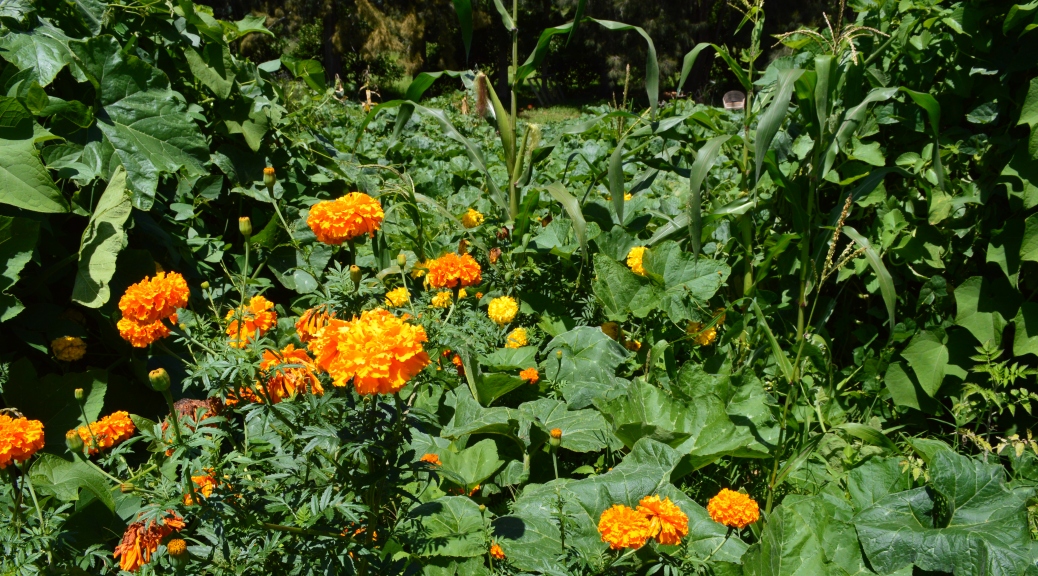Yellow flowered plants will help in your squash patch. It’s that simple. For my very first year of farming, I had no bees. I was there from dawn to dusk, and never saw any. I did have ground dwelling wasps. These wasps worked longer hours than I did, and pollinated the plants. So many instructed me to kill them, but I had a different strategy, I sought to balance the environment.
I did receive one wasp sting when I pinched one under my arm while working, but these are not a deadly or overly aggressive species. I realized that the wasps had begun using my composting planting beds as a home. After taking some time to observe, I looked up videos on how to encourage the wasps to move. It was as simple as placing a large glass mixing bowl over the hole in the ground and removing the bowl a day later. I won’t go into detail about that, but it worked perfectly. They continued to pollinate, but moved their nest elsewhere. I never got stung again, and a more balanced insect population was nurtured in the following years.
I was interested in rehabilitating this parcel, as well as making my squash prolific. I knew it was time to understand bees. I had heard that there were wild honeybee colonies in Hawaii, and I hoped that there might be some in the ranching lands nearby. I learned that bees can see the color yellow, like the squash flowers themselves, but how could I help them find this isolated squash utopia? I learned that yellow was my key planting color, and also to introduce small watering holes for the beneficial insects, toads, and lizards. This was as simple as leaving shallow trays of water near the edge of the squash patch, therefore providing food, water, and habitat as the means to attract them and keep them.
I decided that I could create a beacon of yellow by planting a variety of yellow flowering plants. The beautiful Hawaiian native plant ‘Ilima’ (Scientific name: Sida fallax. Family: Malvaceae (mallow family) were nearby, so I studied how to care for them in the book Native Planters of Old Hawaii. I planted my vines around them and left these historic beautiful native plants where they were. I was careful to consider bees and beneficial bugs of all shapes and sizes. I was going to need big flowers (squash,) small flowers (mustard both wild and domestic, tomatillo,) tall flowers (Lemon Queen sunflowers,) beneficial flowering plants (nitrogen producing pigeon pea,) and a tall heirloom variety of marigold) and of course native flowering plants (Ilima.) Together they became a glowing beacon of biodiversity, and a paradise for pollinators, especially the bees.
It wasn’t long until that bright yellow patch lured the wild honeybees. I would watch them pollinate, then fly way back to the ranching pastures over the stone fence. The wasps stayed and continued working, as did a wide variety of parasitic wasps that enjoyed the smaller blooms. Purple leaved Japanese mustard was a particularly fun addition. Not only did I love to eat the steamed leaves, I used these plants to mark the base of the squash plants. This was helpful, as my squash plants lived about two years, and the water and amendments needed to go at the base of the plant. with over a hundred vines crawling this way and that. a plant like purple mustard was easy to spot, and it would send out stalks of flowers too. I’d also plant some bean plants right there at the base of the squash too, especially my beloved lima beans, so that they would produce nitrogen, small bloomed flowers for the parasitic wasps, and of course food for people.
All of these heirloom varieties were given the opportunity to set seed after the flowers bloomed, creating an endless cycle that kept the pollinators satisfied with a year round food supply. I chose plants based on Hawaii’s growing conditions and soil needs, you may choose different flowers and plants based on your needs. Sunflowers can be tricky where I was growing, because of the high circular winds that would knock them down. Seed saving year after year produced plants that were more adapted to these winds. I chose a tall heirloom marigold from California. It was just a few inches taller than the tallest leaves on the squash, therefore being up and out of the vines so to be seen by the bees. I could go on endlessly about pigeon pea, and I often do. As a shrub, it becomes perennial in Hawaii, and it worked as a nematode fighter, windbreak, pollinator attractant, natural fertilizer, food producing plant for animal and humans, and a shelter for the birds during bad weather. With over 17 years of drought, Hawaiian Ilima plants were becoming scarce. There may also be some yellow flowered native plants in your area that you can help out, as they will also help you.
